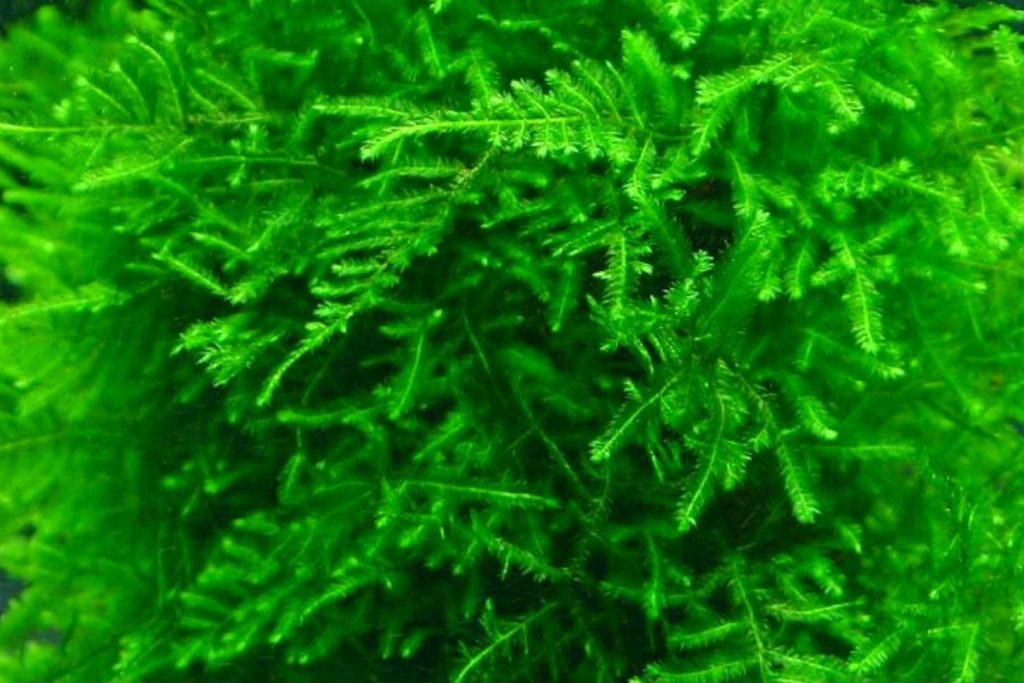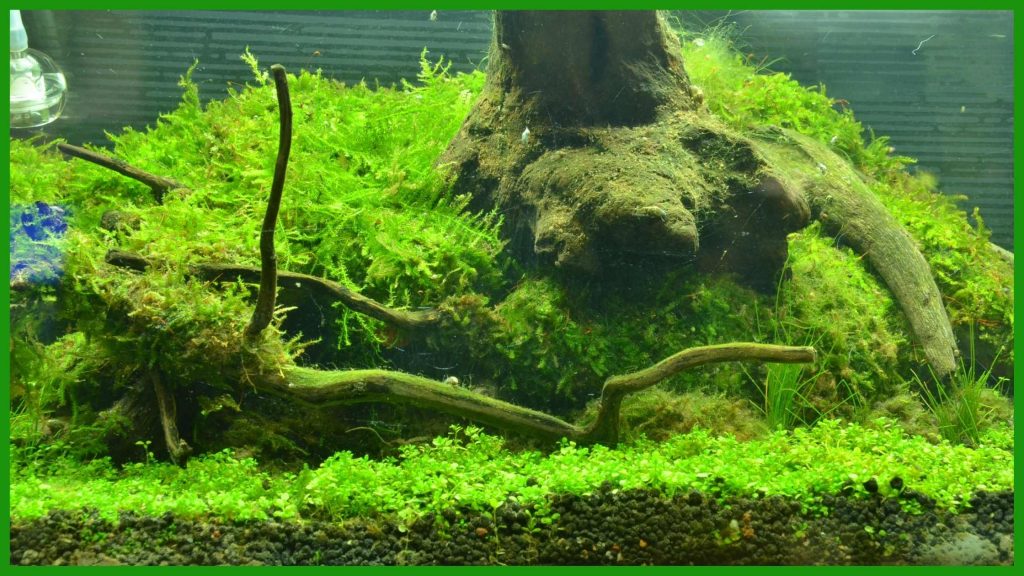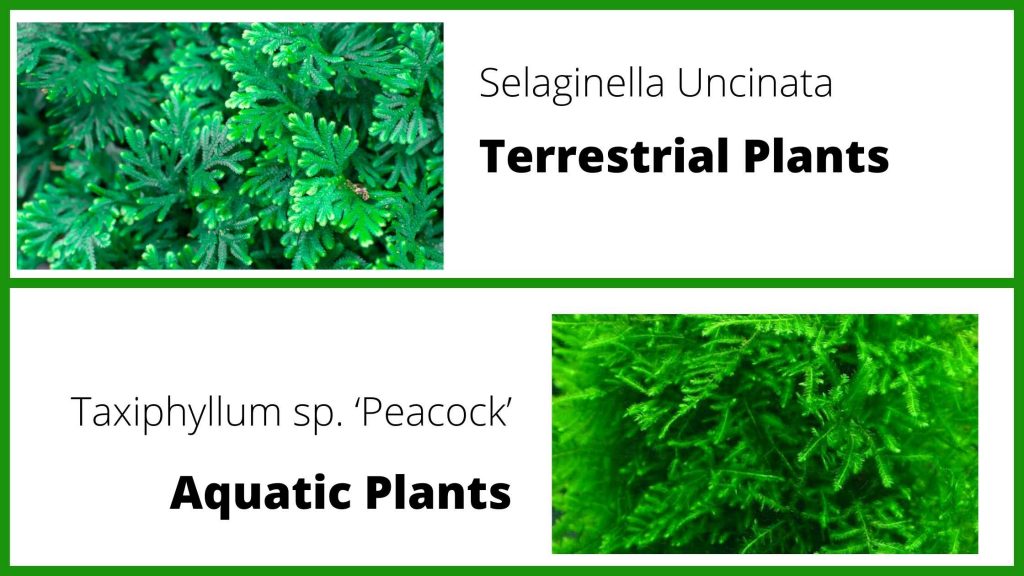I have used Amazon affiliate links on this page. As an Amazon Associate, I earn a commission from qualifying purchases at no added cost to you. Thank you!

Table of Contents
Peacock Moss Introduction
Taxiphyllum sp. ‘Peacock’ or simply Peacock moss is a fast-growing, beautiful aquatic moss species that give your tank the look of a classic riverbed, without invading your original ecosystem. Attaching to pieces of driftwood, rocks, or mats, these beautiful plant colonies provide an attractive home for fish and other critters, while also absorbing unwanted CO2 and producing oxygen helping natural filtration. With its thick, dense growth and bright green color, it also adds a natural-looking accent to your aquarium.
Taxiphyllum sp. ‘Peacock’ is a really popular addition for planted aquariums as its name would suggest, it creates a beautiful display of green amidst the fish within your tank. Perfect for adding to the background of your aquarium, these vibrant strands will draw attention from viewers on all sides. It is also great for attaching to driftwood pieces or rocks. And it is often used to design moss walls.
Why Peacock Moss?

These are some of the best aquatic plants to include in your aquarium due to their unique appearance and ability to cleanse your tank. It gives your fish a place to roam, hide and breed, which is tremendously important for their health and lifespan. It helps to oxygenate your aquarium through the process of photosynthesis by absorbing and converting carbon dioxide into oxygen.
It’s a low-maintenance aquatic moss
As a low-maintenance option for your fish tank, this decorative plant will do its part to control the quality of water in your tank. Peacock moss absorbs nitrates, and phosphates while releasing oxygen into the water, making it one of the most effective ways to filter aquarium water naturally.
It is a great ornamental aquatic plant

These are a very dense, compact variety of moss that can quickly fill in the substrate gaps. Hence once they establish they create a beautiful moss carpet throughout your tank. It’s a great choice for the substrate and will come out more readily than other varieties of moss. Peacock moss also makes excellent, greenery foreground aquascapes.
Peacock moss provides habitat and nesting ground for small fish and other aquatic invertebrates
Peacock moss is a dense and attractive plant that both looks good and has practical benefits. In a submerged setting, it can be attached to the bottom of the tank, granting fish and other lifeforms soft spots to lay eggs. It’s also easy to put on driftwood or rocks and provides a sense of depth when placed on its side. Peacock moss can also float at the top of the water in loose clumps. These floating habitats are favored by small fish like guppies and zebras.
Do you love Angelfish as a planted tank fish? Wanna know how to choose high-quality Angelfish with the longest lifespans? Then read this article, How Long Do Angelfish Live? – Improving Their Lifespan.
Ideal conditions for Peacock Moss
This beautiful moss that’s super easy to care for! It’ll thrive in water with a temperature between 65°F and 77°F, in either soft or hard water, and in any level of lighting. If you use CO2 and strong lighting made for planted tanks, your moss will grow even faster and thicker, but it definitely doesn’t need it to survive! Hence this aquatic moss is a low demanding plant that you can add to your low tech planted tank to give it a heavily planted look. A lot of carpet plants a high demanding and won’t grow without CO2 injection. Peacock moss is an alternative to the expensive, high-demanding carpet plants that you can really try in your low-tech planted tank.
Propagation
Separate individual fronds from the peacock moss at the base of the plant, or cut them off at the stem. Place the fronds into your substrate, or attach them to your driftwood or rocks. Because, when you first add any kind of moss to your tank, they won’t have any weight on them and will be drifting around aimlessly.
You can use a piece of thread or simply glue them to the places you want. They will grow on their own, and eventually, attach themselves to the surfaces of driftwood and rocks.
If you want to propagate your moss faster, There are three things that you can do to encourage their growth and propagate them faster.
- Add an aquarium light rated for planted tanks.
- Add few drops of liquid aquarium fertlizers as prescribed.
Side Note:-
You can use these three methods combined to create a flourishing planted tank in no time. CO2 diffusers, Planted aquarium lighting, and added aquatic plant fertilizers are all very important in high-tech planted tanks, because, most aquatic plants won’t flourish in artificial enclosures like in aquariums without added support.
Now let’s get back to our main topic. Do you want to buy peacock moss online? Then check out below:
Taxiphyllum sp. ‘Peacock’ and Selaginella Uncinata
These are excellent, eye-catching foliage plants for aquariums. They surely can breathe a little life into even the most boring fish tank. However, few people know that there are two different types of peacock moss: Taxiphyllum sp. ‘Peacock’ and Selaginella uncinata. While their names sound similar, both are very different in appearance, texture, and growth habits.
The taxiphyllum sp. Peacock is a delicate species of moss, unlike their more rigid cousins in selaginella uncinata. Its leaves are emerald green and grow in a bush-like pattern that creates a smooth, soft texture. The fronds of the taxiphyllum sp. resemble tiny pine trees, lending to their overall soft appearance.

With one of a kind look, the Selaginella uncinata’s leaves branch out from a central stem and have fine details and edges, almost as if they were each cut perfectly to their shape. And most importantly Selaginella uncinata isn’t an aquatic plant! You can plant them in a terrarium or in a paludarium, but definitely, they won’t survive submerged.
Conclusion
Planting peacock moss is a simple and effortless way to bring a splash of color to your aquarium. It is often used in low-tech aqua scaping, the plant is a popular choice for the foreground and midground areas of the planted aquarium. It is a hearty and forgiving moss that grows well in both hard and soft water. This moss will thrive under normal lighting conditions and without a CO2 diffuser.

Pingback: Duckweed As An Aquarium Plant - Pet Fish 101
Pingback: How Long Are Platy Fish Pregnant For - Pet Fish 101